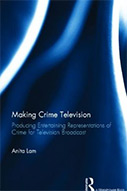Making Crime Television: Producing Entertaining Representations of Crime for Television Broadcast

Author: Anita Lam
Publisher: Abingdon, Oxon: UK; New York: Routledge, 2014. 224p.
Reviewer: Drew Humphries | March 2014
Making Crime Television has a complex agenda. It makes a solid case for actor network theory and draws on the “Latourian laboratory” to show how actors using different frames of reference create and sequentially assemble beats, scenes, episodes and whole TV series. In making this case, the book takes on those who locate meaning in the completed cultural product (content analyses) and those who find it in audience responses. It also criticizes production studies that assume media products are solid, predetermined, or fully formed. In contrast to these production studies, Making Crime Television claims that uncertainty and contingency dominate the production process, and interestingly that such indeterminacy opens the door to failure: characters go missing or plots are changed in assembling scenes or plots. In addition the book offers case studies, based on the author’s ethnographic work with Canadian television companies. More details on method would better help readers evaluate the data or the selective use of it. Nonetheless, case studies are presented to illustrate key theoretical points. Writers may work with stereotypes, but scripts can be transformed by consultants’ insider knowledge of crime and policing. Writers’ stereotypes can be erased and replaced by homogenized characters when network executives review scripts. In a central chapter, the author leads the reader through transformations in assembling basic elements, including location, character, and plot. The last empirical chapter looks at the range of factors that make locations relevant to the creation of a pilot series. The author offers plenty of examples of crime images, from ethnic stereotypes to moral clarity, but she makes no effort to place them in a criminological or criminal justice context. Arguing that distortion is not central to the process of producing meaning, the book misses a chance to bring issues of crime or victimization into the discussion. For this reason, criminologists may find the book frustrating. Media scholars, however, ought to appreciate the book’s important new and complex approach to the production of television crime images.
Drew Humphries, Professor, Department of Sociology, Anthropology, and Criminal Justice, Rutgers University-Camden Campus


